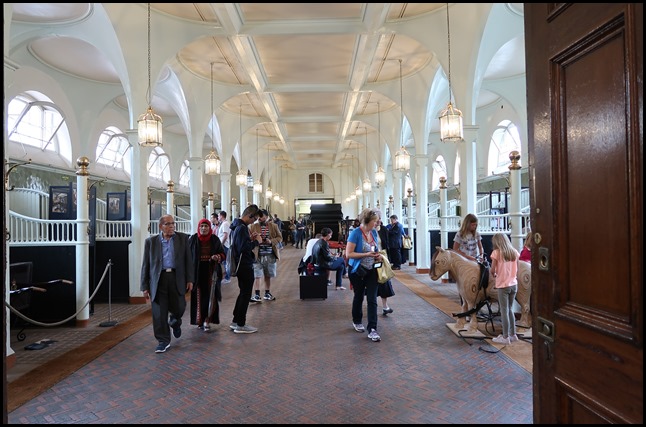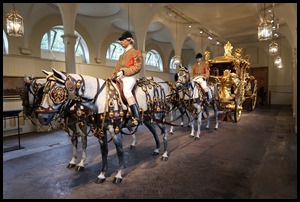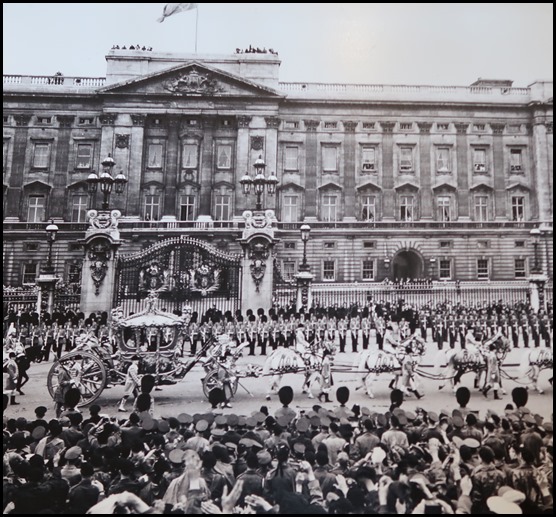Gold Coach

|
The Gold State
Coach
   Looking
back through the State Stables, ahead – first
crossing a narrow road to step in to Whoa, the Gold
Coach.
 Breath-taking to stand so close. Straight to the
information boards.
 The Gold
Coach, one of the most magnificent royal coaches in the world, was
commissioned by George III in 1760. It was delivered to the Royal Mews and
trialled on the 24th of November 1762. The next day, huge crowds turned out to
see the king use it for the first time as he travelled to the State Opening of
Parliament. It worked well, although a pane of glass cracked and one of the door
handles broke. Our guide told us that King George II was a real nuisance as
he kept changing his mind about design and decor.
  Design: The coach was designed by
the architect Sir William Chambers and the panels were
painted by the Florentine artist Giovanni Battista Cipriani. The coach is
7.3 metres long, 2.5 metres high and 3.9 metres wide. It is drawn by eight
horses, with a postilion riding each pair.
  Standing behind the coach you
will notice that the rear wheels are angled outwards. This means that each spoke
hits the ground at 90 degrees which is best for taking the weight and strain of
the four-ton coach. Its weight is such that it never travels faster than walking
speed. A groom walks beside each horse and a brakeman walks directly behind,
ready to operate the brake handle. The role of the brakeman is crucial. Given
the enormous weight of the coach, the brake must be applied approximately 27
metres before the coach’s final stopping point.
 Coronation: The day of Her Majesty The
Queen’s coronation, the 2nd of June 1953, was unusually cold and wet. Not
to be deterred, thousands of people camped out the night before lining the route
of the procession so that they might be able to catch a glimpse of The Queen and
The Duke of Edinburgh on their way to Westminster Abbey.
Preparations began months before
the event. Renovations were carried out to the State Harness and new state
liveries were ordered along with rosettes and scarlet ribbons, which were to be
fixed to the horses’ manes.
The Gold State Coach was drawn by
eight Windsor Greys, twice as long as the arrangement you see today. The route
was the furthest the coach has ever travelled and careful trials were carried
out beforehand, including a midnight rehearsal.
  Today: The Gold Coach was last used on the 4th of June 2002 to convey The Queen and
The Duke of Edinburgh to a Service of Thanksgiving at St Paul’s Cathedral, as
part of the Golden Jubilee celebrations. It is still in working condition, but
whilst on display some of its weight is carried by modern supports. Historically
the coach was kept in the largest coach house in the Royal Mews, which now
houses the Diamond Jubilee State Coach. The Gold State Coach was moved to its
current location to enable visitors to fully appreciate this unique work of
art.
 Part of what Wiki Says: The most dazzling vehicle of
all is the Gold State
Coach, which was built for George III in
1762. Weighing almost four tonnes and requiring eight horses to pull it, it has
carried every monarch to their coronation since 1821.
The horses wear Red Morocco
harness which is used only for this coach.
 Three cherubs on the
centre of the roof represent the guardian spirits of England, Scotland and
Ireland. They support the Sceptre, the Sword of State and the Ensign of
Knighthood in their hands.
The Gold State Coach is an enclosed, eight horse-drawn carriage used by the British Royal Family. Commissioned in 1760, it was built in the London workshops of Samuel Butler. It was commissioned for £7,562 (£1.08 million = US$1.57 million in 2014, adjusted for inflation). This coach has been used at the coronation of every British monarch since George IV. The coach's great age, weight, and lack of manoeuvrability have limited its use to grand state occasions such as coronations, royal weddings, and the jubilees of a monarch.
The coach weighs four tons and is 24 feet (7.3 m) long and 12 feet (3.7 m) high. It is gilded and features painted panels by Giovanni Battista Cipriani and rich gilded sculpture including three cherubs on the roof (representing England, Ireland and Scotland) and four tritons, one at each corner (representing Britain's imperial power).
The body of the coach is slung by braces covered with Morocco leather and decorated with gilt buckles. The interior is lined with velvet and satin. The Gold State Coach is pulled by a team of eight horses wearing the Red Morocco harness. Originally driven by a coachman, the eight horses are now postilion-ridden in four pairs. The coach is so heavy it can only be pulled at a walk. As the coach is suspended from braces, it lacks more modern comfort. Modern coaches such as the Australian State Coach and the Diamond Jubilee State Coach have electric windows, heating and hydraulic stabilisers. In the words of King William IV, a former naval officer, being driven in the Gold State Coach was like being on board a ship "tossing in a rough sea". Queen Victoria complained of the "distressing oscillation" of the cabin. She would often refuse to ride in the Gold State Coach. A later monarch; King George VI said that his journey from the palace to Westminster Abbey for his coronation was "one of the most uncomfortable rides I have ever had in my life".
King George VI had the coach overhauled after the Second World War to rubberise the iron-bound wheels. This would afford at least some comfort to the passengers. The coach is managed by 4 postilions, 9 walking grooms (one of whom walks behind the coach), 6 footmen, and 4 Yeoman of the Guard carrying their long partisans. Eight of the grooms walk beside the horses. The more ornately dressed footmen walk beside the body of the coach. The postilions have to handle the horses when the animals are unruly, and they carry crooked walking-sticks to hold up the traces that may become slack when the coach is taking a corner. The royal coachmen are traditionally clean-shaven.
Bear standing at the rear of the Gold Coach. To the left is a window, below is an enormous frieze which has to be taken down if ever this carriage needs to move out. The window shows the size of the doors (below). It takes a huge team of skilled people two days to get the Gold Coach out with inches to spare each side. Not for the faint-hearted methinks.
I get Bear and Harley to pose and go in search of the coach exit door.
No one can imagine what is behind this ordinary looking door and the skill to remove the occupant.....
ALL IN ALL GORGEOUS IN A GARISH SORT OF WAY A WONDER TO BEHOLD |






